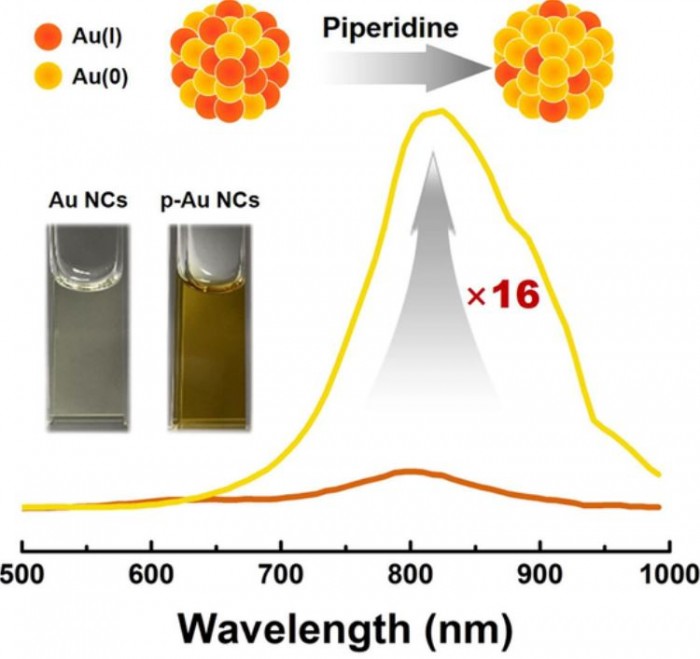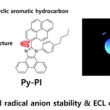댓글 쓰기 권한이 없습니다. 로그인 하시겠습니까?
Enhanced near-infrared electrochemiluminescence of Au nanoclusters treated with piperidine
| Journal | Bioelectrochemistry |
|---|---|
| Author | Jae Hyun Kim, Jeongyun Choi, Jiwoo Kim, Joohoon Kim |
| Citation | Bioelectrochemistry 147 (2022) 1 |
| DOI | https://doi.org/10.1016/j.bioelechem.2022.108192 |

Au nanoclusters (NCs) are considered a promising electrochemiluminescence (ECL) luminophore with biocompatibility and stability that make it suitable for use in bioelectrochemical investigations. The near-infrared (near-IR) ECL of Au NCs is of particular interest for biological applications. In this study, we report the significantly enhanced near-IR ECL of water-soluble Au NCs stabilized with glutathione, which was induced by treating the Au NCs with piperidine. The piperidine treatment of Au NCs enabled a 16-fold enhancement in the near-IR ECL of the NCs in the presence of triethylamine coreactants in water. Compared to the well-known near-IR ECL of Au NCs stabilized with bovine serum albumin (BSA) as a control, the near-IR ECL emission of the piperidine-treated Au NCs (p-Au NCs) was 8 times that of the BSA-stabilized Au NCs. Detailed control experiments suggested that the enhanced near-IR ECL of p-Au NCs could be attributed not to environmental effects (e.g., pH and chemical interference) and the surface ligand effect, but to the reduction of Au(I)-glutathione to Au(0)-glutathione in the NCs. Importantly, the piperidine treatment was also shown to be applicable to different types of Au NCs, such as well-established Au22(SG)18, for improving the ECL emission of the NCs in the near-IR region.
-
Read More

Three-Dimensional TEM Study of Dendrimer-Encapsulated Pt Nanoparticles for Visualizing Structural Characteristics of the Whole Organic-Inorganic Hybrid Nanostructure
Category2021 AuthorYoungwon Ju, Hyun Joo Ro, Yoon Sun Yi, Taehoon Cho, Seung Il Kim, Chang Won Yoon, Sangmi Jun, Joohoon Kim JournalThree-Dimensional TEM Study of Dendrimer-Encapsulated Pt Nanoparticles for Visualizing Structural Characteristics of the Whole Organic-Inorganic Hybrid Nanostructure CitationAnal. Chem. 2021, 93, 5, 2871?2878
-
Read More

Intrinsic size-dependent activity of Pt nanoparticles without masking by heterogeneous oxidation states of Pt for hydrolytic dehydrogenation of NH3BH3
Category2022 AuthorYoungwon Ju,Taehoon Cho,Kichul Lee,Jiwoong Kim,Chang Won Yoon,Joohoon Kim JournalInt J. Energy Research CitationInt J Energy Res.2022;46:9771?9781
-
Read More

Enhanced near-infrared electrochemiluminescence of Au nanoclusters treated with piperidine
Category2022 AuthorJae Hyun Kim, Jeongyun Choi, Jiwoo Kim, Joohoon Kim JournalBioelectrochemistry CitationBioelectrochemistry 147 (2022) 1
-
Read More

Efficient blue organic electrochemiluminescence luminophore based on a pyrenyl-phenanthroimidazole conjugate
Category2022 AuthorKwang-Myeong Kim, Jiwoo Kim, Joohoon Kim*, Jong-In Hong* JournalChemical Communications CitationChem. Commun., 2022, 58, 7542
-
Read More

Distinctive optical transitions of tunable multicolor carbon dots
Category2022 AuthorHyeong Seop Shim, Jun Myung Kim, Seonghyun Jeong, Youngwon Ju, Sung Jae Won, Jeongyun Choi, Sangwon Nam, Aniruddha Molla, Joohoon Kim* and Jae Kyu Song* JournalNanoscale Advances CitationNanoscale Adv., 2022,4, 1351-1358
Designed by sketchbooks.co.kr / sketchbook5 board skin
Sketchbook5, 스케치북5
Sketchbook5, 스케치북5
Sketchbook5, 스케치북5
Sketchbook5, 스케치북5
.png)


 Intrinsic size-dependent activity of Pt nanoparti...
Intrinsic size-dependent activity of Pt nanoparti...
 Efficient blue organic electrochemiluminescence lumin...
Efficient blue organic electrochemiluminescence lumin...